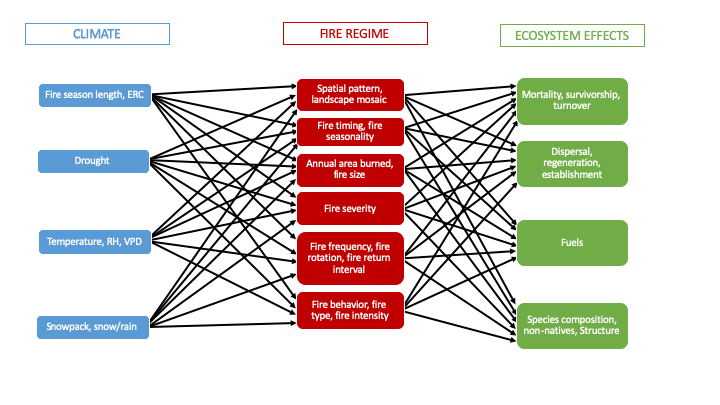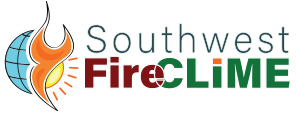
Comprehensive review of the existing scientific understanding of climate-fire-ecosystem interactions and implications for management, and new research on drivers of fire and vegetation in the Southwest.
Linkages and Literature Review
The conceptual framework underlying the FireCLIME literature review and
science synthesis is represented in the network of ‘linkages’ between key
climate, fire, and ecosystem variables shown in the figure below:

Our team identified publications related to climate-fire interactions and
synergies, and their effects on ecosystem characteristics in the southwestern
US. Each paper was reviewed and coded with individual terms from our lists
of four climate, six fire regime, and four ecosystem effects variables. In
combination, these variables form 48 unique ‘linkages’ between climate &
fire or fire & ecosystem effects.
Workshop

In fall 2016, we held a science-management workshop in Albuquerque, NM to bring together researchers, fire managers, and members of the NGO sector to synthesize the current understanding of climate, fire and vegetation (fuel) dynamics, building from existing literature and ongoing studies. 47 participants attended the workshop and provided feedback to the FireCLIME team on preliminary results from the literature review, and the direction of modeling work.
Drivers of Fire and Vegetation in the Southwest
We combined vegetation, fire, and climate variables derived from available
data resources to evaluate relationships among elevation, productivity,
climate variables, and mean fire frequency. Results show that vegetation and
productivity are tightly coupled with climate, but fire regimes are more
variable, reflecting the stochastic nature of fire occurrence and spread.
Vegetation and fire regimes appear likely to shift recursively under the
influence of changing climate.









